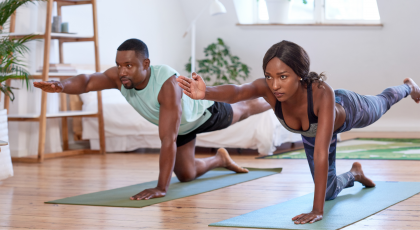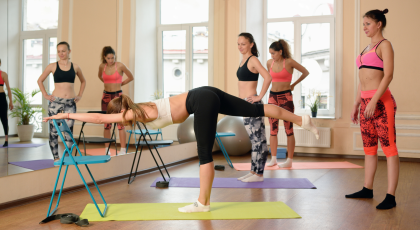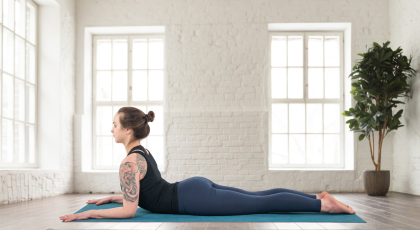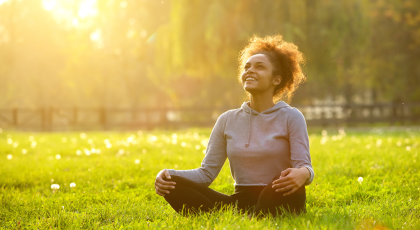View basket (0 items $0.00)
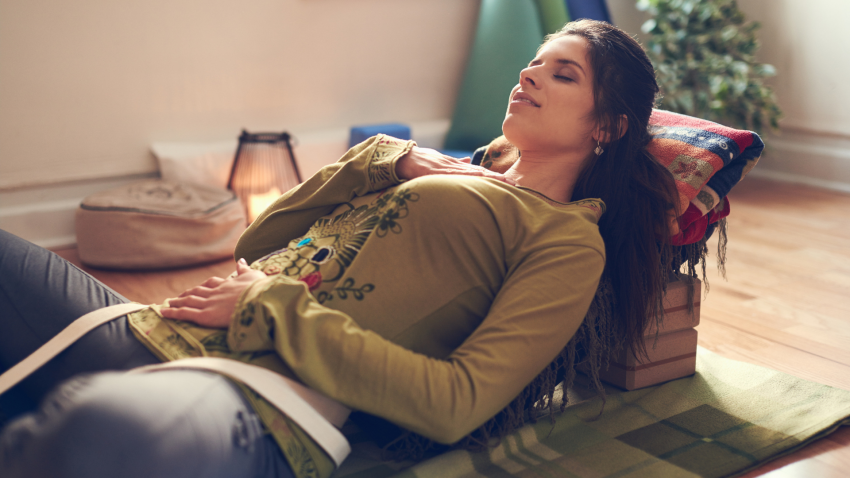
Cancer and Stress: A Healing Yoga Practice to Calm Anxiety
Anxiety is one of the most common side effects along the entire spectrum of the cancer journey. Nearly all patients will experience anxiety at one point or another, including after receiving a diagnosis, anticipating and receiving treatment, affording treatment, anticipating recurrence, ending treatment, and becoming a long-term survivor.
For many, the fear of recurrence is genuine and something that does not diminish with time. The rate of recurrence varies depending on the type of cancer. Chances of recurrence for early-treated breast cancer can be as low as 5 percent, while glioblastomas and ovarian cancers can approach an 85 percent or higher recurrence rate. Up to 7 percent of cancer survivors develop a disabling fear of recurrence that severely impedes the quality of life.
Stress, Anxiety, and Cancer
Cancer patients may experience generalized anxiety or other diagnoses such as phobias, panic attacks, obsessive-compulsive disorder (OCD), health anxiety disorders, and post-traumatic stress disorder (PTSD). Symptoms of these may vary but can include increased heart rate, shortness of breath, muscle tightness, heightened pain, insomnia, sweating, nausea, restlessness, and irritability.
Also, how patients feel about their stress and anxiety impacts how much stress affects their physical and mental health. One study out of Harvard reported that those who had high levels of stress and believed stress negatively impacted their health experienced premature death rates that were 43 percent higher than those who did not believe their high levels of stress were harmful.
The Stress Response and Immunity
 The stress response—commonly called the “fight-or-flight” response—turns off the parasympathetic (rest-and-digest) nervous system and reduces bodily functions not necessary for immediate self-preservation. Stress suppresses the lymphatic system, which in turn slows the immune response. As far back as 1965 psychiatrist, George Solomon published some of the first findings in the field of psychoimmunology, studying the link between stress levels and immune responses.
The stress response—commonly called the “fight-or-flight” response—turns off the parasympathetic (rest-and-digest) nervous system and reduces bodily functions not necessary for immediate self-preservation. Stress suppresses the lymphatic system, which in turn slows the immune response. As far back as 1965 psychiatrist, George Solomon published some of the first findings in the field of psychoimmunology, studying the link between stress levels and immune responses.
When stress is perceived as harmful and chronic, it can inhibit immune function. However, it does not when stress is perceived as an opportunity to rise to a challenge. When we experience a stressful event, whether it is the diagnosis of a life-threatening disease, or something as commonplace as getting cut off in traffic, the body responds automatically by secreting stress hormones.
One of these is cortisol, which raises blood sugar and metabolizes white blood cells to provide energy for the fight-or-flight response. Unfortunately, when stress becomes chronic, cortisol levels remain high even during rest. This can decrease immunity by inhibiting T-cell production. Our T-cells are what protect the body from invading viruses, allergens, and mutated cancer cells.
When a challenge is perceived, adrenaline is also produced. Adrenaline increases blood pressure and heart rate to create a rush of energy so we can respond to the challenge. But over time, sustained production of adrenaline causes a higher-than-normal baseline to be set by the body, which taxes the organs, increases insulin production, and keeps blood pressure high.
Tend-and-Befriend Response
Fortunately, our bodies have a built-in mechanism for stress resilience, the hormone oxytocin. Also secreted as part of the stress response, oxytocin protects the cardiovascular system from the effects of stress. It works as an anti-inflammatory and keeps muscles more relaxed. Oxytocin encourages us to seek emotional support from others and helps us to notice when others are struggling, and when we do, more oxytocin is released. 
Particularly for women, the “tend-and-befriend” response is tied to higher levels of oxytocin and causes us to tend to those around us who are in need and to befriend by seeking out social support. Better stress outcomes can be expected when patients have emotional and social support in place. Emotional and social support can include support groups, therapy, education, and wellness communities, including yoga class communities, especially yoga classes for people managing cancer.
Perhaps this speaks to why more women tend to seek out social support systems when undergoing diagnosis and treatment for cancer.
How Yoga Helps Anxiety
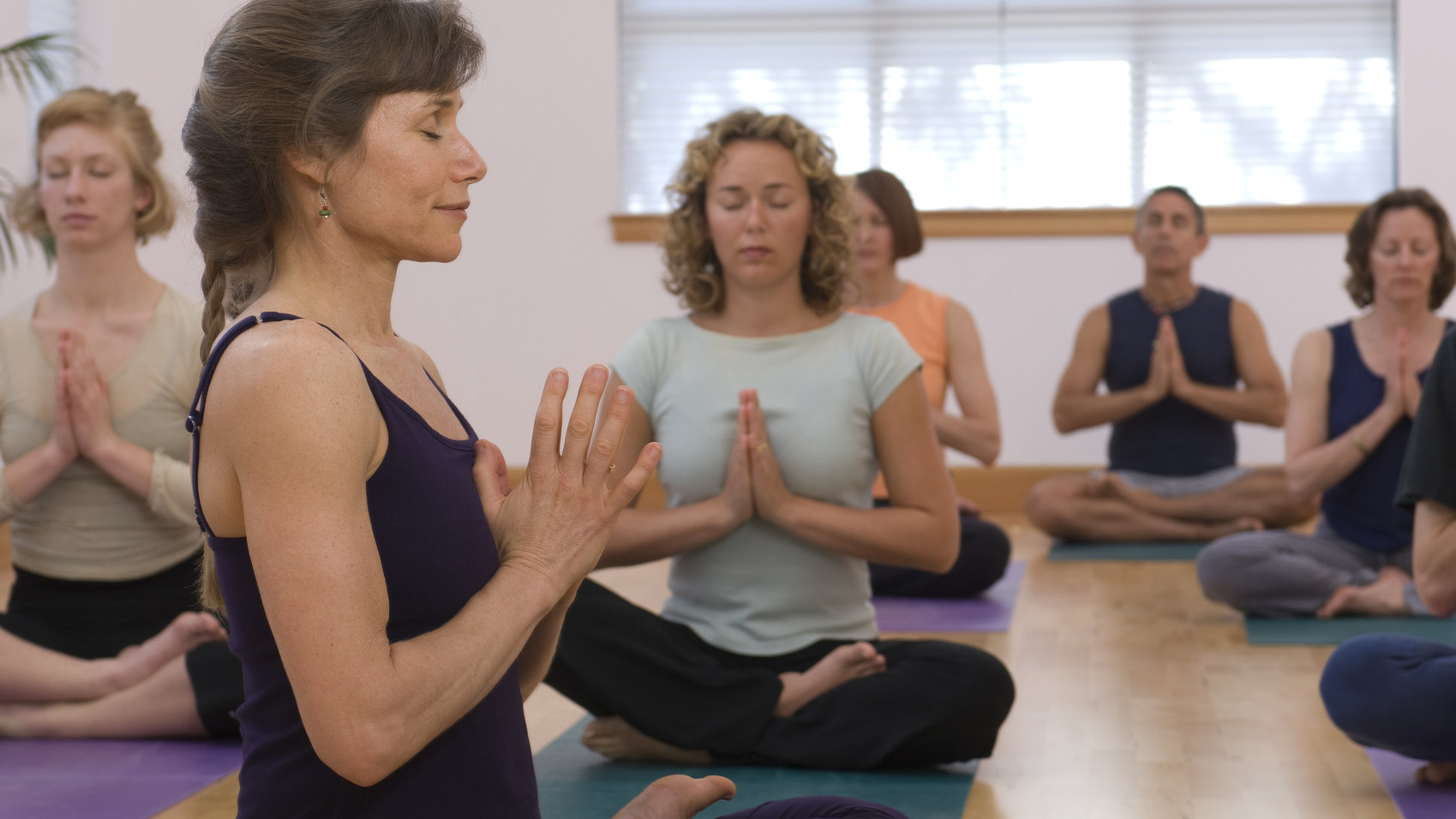
The good news is that yoga and other mindfulness practices modulate the stress response by lowering heart rate, blood pressure, and respiration rates, and increasing heart rate variability, which is an indicator of how well the body responds to and recovers from stressful events. Studies suggest the positive impacts of consistent yoga practice on mental and emotional well-being in cancer patients.
Specifically, yoga has been shown to improve mood, reduce symptoms, reduce stress, and improve quality of life. Besides improving these measurable health markers, yoga can lead to a sense of empowerment and mastery over the body and mind, which can be an essential factor in reducing stress and anxiety.
What follows is a simple sequence of yoga practices, including intention setting, a mudra for anxiety, a simple sound practice to help calm the mind, a supported version of Balasana (Child’s Pose) (instructions and photo below) to help you draw awareness inward and also a calming pranayama practice. Done together, these practices can help you cope with the anxiety caused by the diagnosis, treatment, or survivorship and allow you to feel more like yourself.
Yoga Practice Tips
-
Do a little yoga each day to give yourself the time and space to heal. Make yoga a permanent part of your life after cancer.
-
Stay mindful of the body and breath throughout the practice. Only move within a comfortable range of motion. If you become uncomfortable, dizzy, nauseous, or breathless, stop immediately and rest for a few moments.
-
For this practice, a yoga mat, a firm blanket, and two or more bolsters or pillows will be helpful.
Setting Your Sankalpa with Anjali Mudra
Intention setting, or creating a Sankalpa, is an important first step toward using yoga as a healing practice. It serves as a reminder of your goals during this time.
-
Begin sitting in a comfortable seated position with your palms together at your heart. This hand position, Anjali Mudra (Prayer Position), helps to draw your awareness inward.
-
Take a few deeper breaths and recall your current challenges. Recognize that challenges are opportunities for growth and healing.
-
Begin to imagine the best possible outcome for your current situation, setting aside any feelings of doubt that arise.
-
Allow your Sankalpa to arise formed into a simple statement phrased in the present tense beginning with “I am … ”, or “My … ”. If you find it difficult to create an intention at this time, use the statement “I am calm and worry-free.” State your Sankalpa silently three times and trust that it will manifest with patience and repetition.
How to Practice Adhi Mudra for Anxiety 
Adhi translates to “first” because this is the first mudra we do in the womb. It is a self-soothing gesture and comforts us during anxious times. Adhi Mudra draws the excess mental activity down into the body where it can be processed and grounded.
I also call this one of the “sneaky” mudras because you could easily hold your hands in this position during a difficult conversation and no one will know that you are doing something to ease your anxiety.
-
Hold your thumbs in the center of your palms and wrap your other fingers lightly around each thumb.
-
Rest the knuckles of your hands downward on your lap.
-
Soften your shoulders and release your forearms.
-
Hold this gesture for a few minutes and notice how it feels, then release your hands.
Vowel Spiral 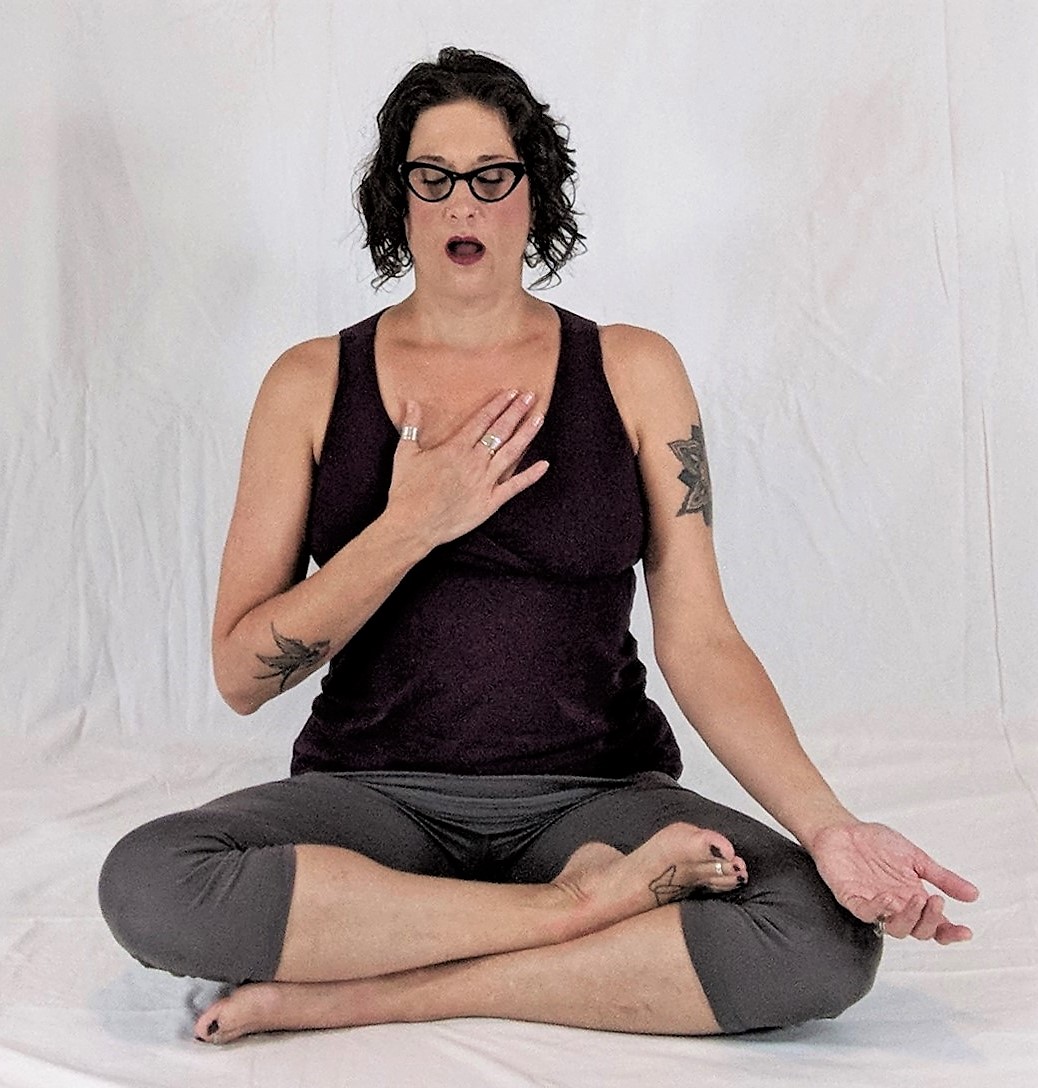
Using your voice to create a shift in your mental state is a powerful tool to combat anxiety. This practice uses simple vowel sounds that cause vibration in specific parts of the torso and head. As awareness is drawn into these areas, the mind can be freed from circular thinking that might cause anxiety.
As you chant, focus on what the sound feels like in the body, how the vowels sound, and how smooth the tone is. You may notice breaks and warbling in the tone if your mind wanders or if your exhalation is not smooth. Work to smooth out the tone and make sure that you stop sounding before you run completely out of breath, so you are left feeling relaxed, not breathless, and rushed.
Chanting simple sounds is one of the fastest, most effective ways to center the mind and emotions. When you are anxious, you can imagine that your cells are vibrating in dissonance at an atomic level. When you chant, you bring your atoms into resonance and harmony, and you can truly feel the difference almost immediately. Give it a try!
-
Begin sitting in a comfortable position on the floor on a folded blanket, or in a chair.
-
Take a few moments to breathe naturally and allow your inhalations to flow down into your lower abdomen.
-
Bring one hand to your lower sternum, inhale naturally, then as you exhale chant an “Ahhh” sound (like “father”), noticing a vibration in your mid-chest.
-
Move your hand to your upper sternum, inhale naturally, then as you exhale chant an “Aaa” sound (like “way”), noticing vibration at your heart center.
-
Move your hand to your belly, inhale naturally, then as you exhale chant an “Ooo” sound through very round lips (like “donut”), noticing vibration at your navel center.
-
Move your hand to your forehead, inhale naturally, then as you exhale chant an “Eee” sound (like “free”), noticing vibration in your skull.
-
Move your hand to your hip point, inhale naturally, then as you exhale chant an “Uuu” sound (like “noodle”), noticing vibration in your pelvis, legs, and feet.
-
Move your hand to the crown of your head, inhale naturally, then as you exhale chant an “Mmm” sound, noticing vibration at your crown.
-
Repeat the entire sequence two more times beginning and ending with the “Ahh” sound at the heart center. Observe how the vibration spirals from the heart outward toward the crown and pelvic floor.
How to Practice Supported Balasana (Child’s Pose) 
Coming into a fetal position can feel like a balm for frayed nerves. It enables you to turn your awareness toward the internal landscape of sensation, breath, and thought, and away from the things outside of yourself that may be causing anxiety and stress. However, this pose can be difficult if your knees or hips are not comfortable in deep flexion. If you have access to bolsters or pillows, you can support your hips, thighs, and torso so that Supported Balasana can be maintained for several minutes in comfort and relaxation.
-
Place a folded blanket on your mat, so you have something soft to kneel on.
-
Straddle one bolster as if you were sitting on a horse.
-
Place the second bolster perpendicular to the first in front of your knees.
-
Lengthen your torso forward so that your chest and belly are resting on the bolsters.
-
Turn your head to one side and rest your forearms on the floor, or support your forehead on the backs of your stacked hands.
-
A third bolster may be helpful to place on top of the first two if you are not comfortable folding your torso forward into Child’s Pose. You want to place your torso so that your hips are at or below your head level. Additional bolsters can be straddled until you are comfortable.
-
If this version of Balasana is not comfortable, or you don’t have access to props, feel free to recline on your back with your knees drawn into your chest. It is the same posture in a different relationship to gravity.
-
Rest here for several minutes and practice breathing in and out in a slow and relaxed way.
-
Return to a seated position as soon as you begin to receive messages from your hips or knees that you need to come up. Never stay past the point of comfort.
Rechaka Kumbhaka Pranayama (Exhale Retention) 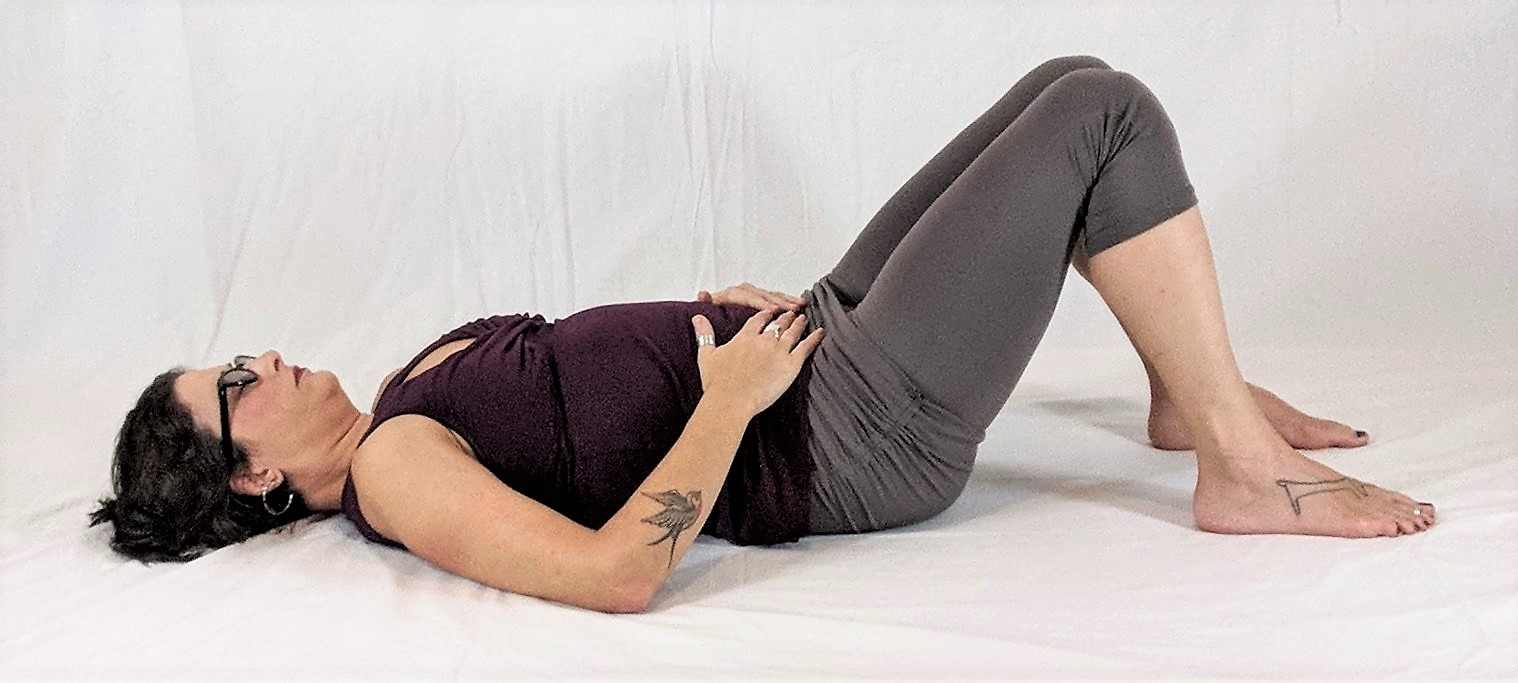
Conscious breathing is a simple yet effective way to shift your mindset when you are worrying or feeling anxious. It is an amazingly powerful tool that is always there for you when you have a few moments to focus on your breath. Bringing awareness to a slow, relaxed exhalation will activate the parasympathetic nervous system, helping to reduce the effects of anxiety by reducing stress hormones, heart rate, and blood pressure. The practice of lengthening the exhalation can increase the stress-reducing effects even more.
-
Recline comfortably with support under your head and knees if needed. Your blanket or pillow will come in handy here. You can also simply leave your knees bent with the soles of your feet on the floor.
-
Close your eyes and feel your breath moving smoothly in and out of your nostrils.
-
Place your hands on your lower belly, and as you inhale, notice if there is a natural lifting of the abdomen, and a gentle softening of the belly on the exhalation.
-
Take a normal-length inhalation, and then slowly begin to lengthen your exhalation by one or two beats. You do not need to count your breath, but try to make the exhalation slightly longer than your inhalation.
-
This should only be done at a comfortable speed and pace, never to the point of breathlessness or frustration.
-
After five or so breaths with a longer exhalation, notice if there is a natural pause at the end of the exhalation where the breath rests.
-
Inhale, exhale long and slow, and then pause where the breath is neither moving in nor out.
-
Allow that rest to last for a few beats, then continue breathing.
Repeat this pattern for several minutes, then return to your normal everyday breathing pattern.
Savasana (Relaxation Pose) 
It is important to give yourself a few minutes at the end of your practice to rest in stillness and silence so that the gifts of the practice can be fully integrated into your body and mind.
-
Recline with your legs extended and feet relaxed to sides.
-
Rest your arms at your sides and turn your palms to face the ceiling.
-
You may use support under your knees if your low back is uncomfortable when your legs are extended out flat on the floor. You can also add a folded blanket under your head. Relax here for at least 5 minutes.
When you are ready to sit back up, take your time rolling over to your favorite side, resting there for a few moments while you repeat your Sankalpa from the beginning of the practice. Then use the strength of your arms to press yourself back up to a seated position.
Here's another article from Cheryl Fenner Brown's series on Yoga for Cancer - Cancer, and Insomnia: A Short, Relaxing Sequence to Put You on the Path to Sleep.

 Cheryl Fenner Brown, C-IAYT, ERYT 500 works with cancer patients and people over 50 in central North Carolina. Her 700-hr Hatha training at Piedmont Yoga Studio and 1000-hr Integrative Yoga Therapy training inform her unique blend of alignment principles with subtle energy work, sound, mudra, and Yoga Nidra. She teaches classes, privates, self-care retreats and enjoys mentoring teachers in a 100-hr Adaptive Yoga Mentorship. Her Healing Yoga for Cancer Survivorship DVD is based on her feasibility study presented at IAYT's Symposium on Yoga Research and the Society of Integrative Oncology's annual conferences in 2015 and highlighted in Yoga Journal. From this work, she developed a 50-hr Healing Yoga for Cancer teacher training that is offered nationwide, find out more at www.yogacheryl.com.
Cheryl Fenner Brown, C-IAYT, ERYT 500 works with cancer patients and people over 50 in central North Carolina. Her 700-hr Hatha training at Piedmont Yoga Studio and 1000-hr Integrative Yoga Therapy training inform her unique blend of alignment principles with subtle energy work, sound, mudra, and Yoga Nidra. She teaches classes, privates, self-care retreats and enjoys mentoring teachers in a 100-hr Adaptive Yoga Mentorship. Her Healing Yoga for Cancer Survivorship DVD is based on her feasibility study presented at IAYT's Symposium on Yoga Research and the Society of Integrative Oncology's annual conferences in 2015 and highlighted in Yoga Journal. From this work, she developed a 50-hr Healing Yoga for Cancer teacher training that is offered nationwide, find out more at www.yogacheryl.com.
References
-
Primeau, A., (2018) Cancer Recurrence Statistics, Cancer Therapy Advisor https://www.cancertherapyadvisor.com/home/tools/fact-sheets/cancer-recurrence-statistics/
-
National Cancer Institute (2019) Adjustment of Cancer: Anxiety and Distress (PDQ®)-Patient Version https://www.cancer.gov/about-cancer/coping/feelings/anxiety-distress-pdq#_336
-
Velikova G, Selby PJ, Snaith PR, et al. (1995) The relationship of cancer pain to anxiety. Psychother Psychosom 63 (3-4): 181-4.
-
Keller, A., Litzelman, K., Wisk, L. E., Maddox, T., Cheng, E. R., Creswell, P. D., & Witt, W. P. (2012). Does the perception that stress affects health matter? The association with health and mortality. Health Psychology, 31(5), 677–684. doi:10.1037/a0026743
-
Mukherjee, S. (2010) The Emperor of All Maladies: A Biography of Cancer. Scribner.
-
Dess, N.K., (2000). Tend and Befriend: Women tend to nurture and men to withdraw when life gets hard. Psychology Today, https://www.psychologytoday.com/us/articles/200009/tend-and-befriend
-
Harvard Medical School (2008, updated 2018) Yoga for anxiety and depression: Research suggests that this practice modulates the stress response. Harvard Health Publishing, https://www.health.harvard.edu/mind-and-mood/yoga-for-anxiety-and-depression
-
Smith KB, Pukall CF. (2009) An evidence-based review of yoga as a complementary intervention for patients with cancer. Database of Abstracts of Reviews of Effects (DARE), https://www.ncbi.nlm.nih.gov/books/NBK77050/
-
Pilkington, D., Gerbarg, P.L., & Brown, R.P. (2016) Yoga therapy for anxiety. The Principles and Practice of Yoga in Health Care. Handspring Publishing, 95-113.
-
Culos-Reed., S.N., Long, R., Walter, A.A., Van Puymbroeck. M. (2016) Yoga Therapy for Cancer Survivors. The Principles and Practice of Yoga in Health Care, Handspring Publishing, 375-395.
Featured Courses
